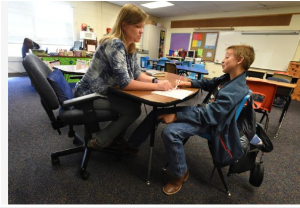Twelve-year-old Jonathan Mikita arrives at Cindy Kanuch's classroom Wednesday with a big grin on his face. He

whips out a pair of headphones, opens a thick book, finds the right chapter and begins reading. Or rather, his school-issued iPad reads to him, and he follows with his eyes.
"I get to read books I wouldn't have before," says Jonathan, a sixth-grader at Calhan Middle School.
A few years ago, there would have been no way Jonathan, who has severe dyslexia, could have devoured a 400-page fantasy book about legendary horses that live in the ocean.
But a variety of advanced teaching tools - such as "ear reading" - and Kanuch's expert guidance have helped him and other students in Calhan School District RJ-1 discover the joy of reading and get even smarter.
"I'm so proud of him," Kanuch said. "This is a brilliant child, but because of the way testing is set up, we can't see what he knows."
For her work with students who struggle with the written word, Kanuch, a learning reading specialist for RJ-1, is the recipient of a new national award, the Winslow Coyne Reitnouer Excellence in Teaching Award, presented by Learning Ally.
The national nonprofit organization headquartered in Princeton, N.J., produces an online library of 80,000 narrated audio textbooks and literature for people with blindness, visual impairment, dyslexia and other reading disabilities.
Kanuch is one of two teachers singled out of 140 nominations to win the inaugural award. As part of the recognition, she will attend a Reading in the City conference in Denver from Thursday through Sunday and speak at several sessions.
She'll talk about how she tells students that asking questions is a sign of strength and not weakness, that they need to speak up if their needs aren't being met, and that they should always persevere to arrive at success.
Kanuch will outline for other educators how she helped her school vault from the bottom of academic achievement on the state's rating system, called turnaround, up three levels of academic performance in just one year. Focusing on reading, using data to pinpoint student deficiencies, was the key, she said.
"We looked at what do students need, and used research-based programs to help them," she said.
Kanuch has been teaching for 14 years in Calhan, which houses all grades in one building. It's home for her; she's a graduate of Calhan High.
Jonathan was the catalyst for her to work to find solutions for students with reading difficulties. A few years ago, she was reading aloud the math and writing portions of standardized state assessments to him, but when she got to the reading part, he had to be on his own.
"He was reading 20 words a minute at best, and I could see him deflate. He looked at me, crying, saying 'Why do they do this to me? Why do they make me feel dumb?' I vowed to do whatever I could to help him."
A multi-sensory approach works best, Kanuch said.
"It's saying, seeing, hearing and writing all at the same time," she said, "to make sure the information is getting in their brains in all different ways."
Because when it comes down to it, as Jonathan has learned, it's not about how fast you read or whether it's your lips or another person's that are moving, but what you comprehend from reading.
"It doesn't matter how words come off the page," Kanuch said. "It levels the playing field when you can use audio and follow along visually."
RJ-1 Superintendent Linda Miller said Kanuch has brought "explicit, systematic, intensive instruction" to the reading intervention program.
"She identifies the learning gap in students and works to fill it," Miller said. "She's also helped teachers understand how to identify and fill these gaps."
That's why special education teacher Cindy Henry nominated Kanuch for the award. Kanuch encouraged other teachers to attend literacy conferences and introduced them to a program that mimics how dyslexic minds operate. Teachers were tasked with drawing a picture in front of a mirror, but could only look in the mirror, not at the paper.
"My whole paper was one big scribble," Henry said, "and I was giving it my best. I thought, 'My poor kids.' Our school has made phenomenal gains, and a big part of it is the reading program."
Kanuch's work starts as soon as children enter RJ-1. She heads a tutoring program that pairs high school students with kindergartners who are behind in knowing what sounds letters make.
Sophomore Jonathan Brown has been working every school day for half an hour with 6-year-old Cameren Schroeder.
"He makes it fun to teach him because he has a good attitude and he's always smiling," Jonathan said. "I'm very proud of him."
Like teacher, like student.
See the story in the Gazette
here.